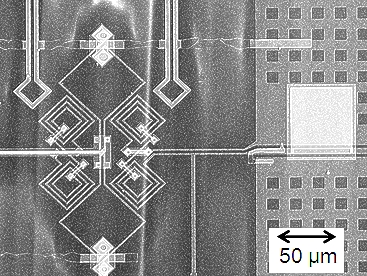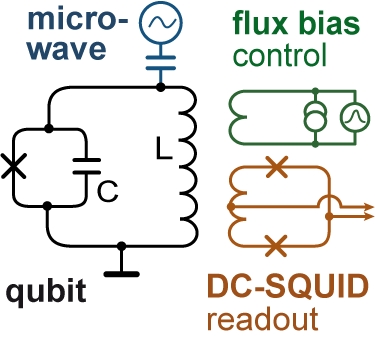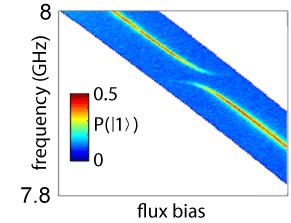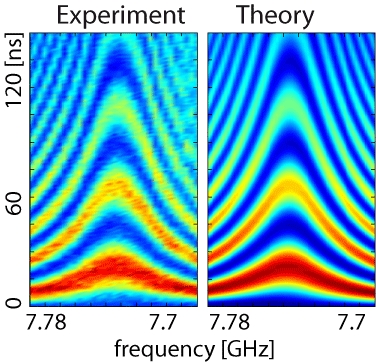B3.5: Nanoscale Quantum Memory for Superconducting Qubits
Subproject Leader: Alexey Ustinov
Contributing Scientists:
Present: Philipp Jung
Past: Pavel Bushev, Tobias Wirth
Quantum-jumping atoms
The atoms in amorphous materials are not arranged in a crystalline order. Therefore, for some atoms, not every binding electron may have found a partner, and so-called dangling bonds are formed. Such weakly bound atoms may tunnel between two lattice positions forming so-called two-level systems (TLSs). The atomic jumps may be driven both by thermal activation and quantum tunneling.
Ubiquitous two-level systems (TLSs)
TLSs are detrimental to nanofabricated devices. They affect the performance of mechanical and electromagnetic micro-resonators by introducing extra loss and have been also identified as a source of 1/f noise. Only recently, it became possible to study the properties of individual coherent TLSs. This requires a strong coupling of a single TLS to a measurement apparatus and also some means to manipulate its state. In our work, we use the new technology of superconducting quantum bits, of which specifically the phase qubit turns out to be an ideal system to manipulate and detect single nanoscale TLS.
Superconducting qubits as TLS detectors
About 10 years ago, superconducting circuits were first operated in the coherent quantum regime. Ever since, a huge progress has been made to improve their coherence times, which have grown by 3-4 orders of magnitude, and a variety of quantum bit architectures has been invented. When TLSs are present in the tunnel barrier of the qubit’s Josephson junction, they may couple strongly to its macroscopic quantum state via an electric dipole coupling. This coherent interaction can be exploited to manipulate and measure the TLS quantum state.
Using TLSs as qubits and quantum memories
TLSs are a source of decoherence in superconducting qubits. On the other hand, the coherence times of nanoscale TLSs may exceed greatly those of the macroscopically tailored qubits. While today’s phase qubits have energy decay times T1 of about 500 ns, up to 10 µs could be measured in a TLS. They may therefore be used as the active qubits in quantum computing architectures or play the role of a memory to store quantum information. We developed technique [1] to manipulate individual TLS directly by applying resonant microwave field, which provides an efficient method to perform single-qubit gates on a TLS.
Entanglement, coherence and beyond
The hybrid quantum system consisting of a macroscopic superconducting qubit and a number of nanoscale coherent defect states offers a variety of research opportunities. For example, we studied three-partite interaction [2] by mediating entanglement between two TLS via the qubit. Our current experiments focus on measurements of the coherence properties of TLS in dependence of their interaction strength with the qubit, the sample temperature and mechanically applied stress. Our recent results form the basis of a thorough theoretical understanding [3,4,5] of the TLS nature, which is developed in close collaboration with the theory groups at CFN.
References
| [1] | J. Lisenfeld, C. Mueller, J. H. Cole, P. Bushev, A. Lukashenko, A. Shnirman, and A. V. Ustinov, Measuring the temperature dependence of individual two-level systems by direct coherent control, Phys. Rev. Lett. 105, 230504 (2010) |
| [2] | G. J. Grabovskij, P. Bushev, J. H. Cole, C. Müller, J. Lisenfeld, A. Lukashenko, and A. V. Ustinov, Entangling microscopic defects via a macroscopic quantum shuttle, New J. Phys. 13, 063015 (2011) |
| [3] | J. Lisenfeld, C. Müller, J.H. Cole, A. Lukashenko, A. Shnirman, and A.V. Ustinov, Rabi spectroscopy of a qubit-fluctuator system, Phys. Rev. B (Rapid Commun.) 81, 100511 (2010) |
| [4] | ] P. Bushev, C. Müller, J. Lisenfeld, J. H. Cole, A. Lukashenko, A. Shnirman, and A. V. Ustinov, Hybrid quantum system surveyed using multi-photon spectroscopy, Phys. Rev. B 82, 134530 (2010) |
| [5] | J. H. Cole, C. Müller, P. Bushev, G. J. Grabovskij, J. Lisenfeld, A. Lukashenko, A. V. Ustinov, and A. Shnirman, Quantitative evaluation of defect-models in superconducting phase qubits, Appl. Phys. Lett. 97, 252501 (2010) |
List of Publications 2006-2011 as PDF
Subproject Report 2006-2010 as PDF




